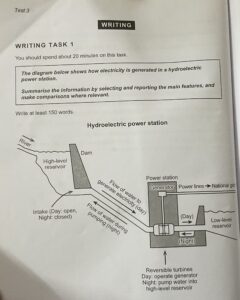
The diagram illustrates the process of generating power in a hydroelectric power station. River water is utilised to generate power in the day that is sent to the national grid, whereas at night the water is pumped back into the initial reservoir.
In the day stage, the river water flows into a high-level reservoir with a dam and through the opening at the bottom, the water flows towards the power station situated at a lower level. The generator there converts energy of the water into electric energy which is transported through power lines to a national grid. The used water is kept in a low level reservoir from where it is pumped back by turbines at the bottom of the power station to the same high level reservoir at night. The next day this cycle of water flow and electric energy generation continues.
Overall, the process of power generation using river water in a power station is divided into day and night stages.
